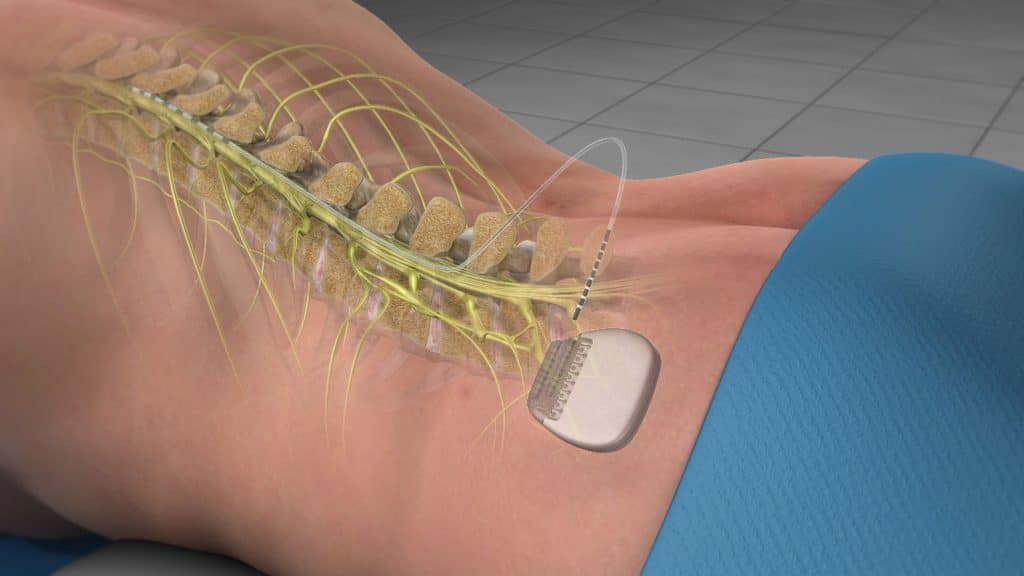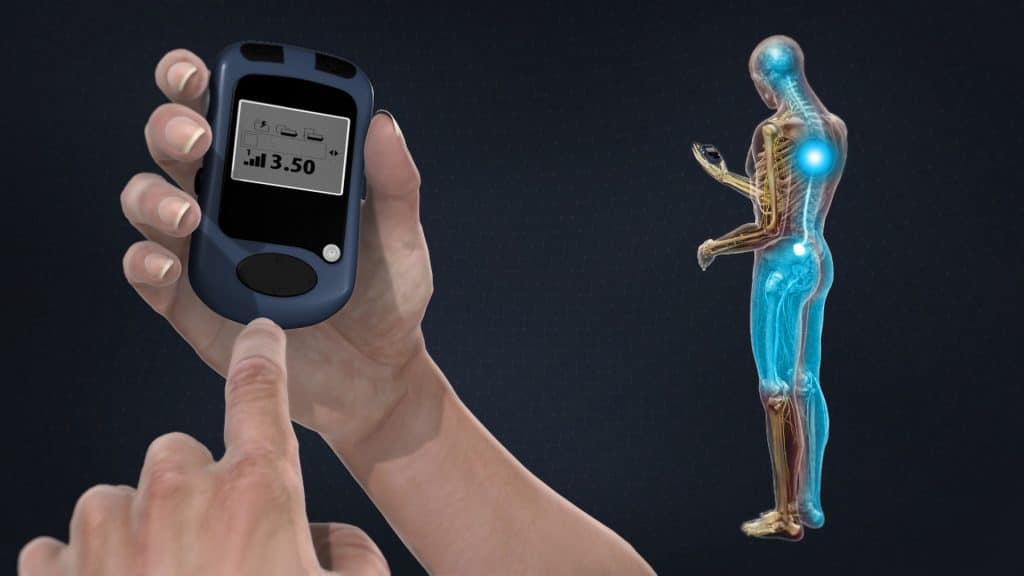Overview
Neuromodulation refers to therapeutical procedures for the treatment of chronic pain, which aim to modify the transmission of pain signals to the central nervous system by electrical or chemical nerve stimulation. The controlled impulses stimulate, inhibit, regulate or alternate the activity of single neurons or neuronal networks.
Main target of these methods is the inhibition or modification of pain signaling to the brain, in order to relieve the annoying symptoms. Instead of pain a decent pleasant tingling sensation is experienced in the affected area.
Neuromodulation can be performed by stimulation of spinal cord, stimulation of nerve fields or by peripheral nerve stimulation, either by implanted medical devices or by local application of chemical agents.
Anatomy (spinal cord)
Spinal cord consists of neuronal cells and is continuation of the brain. It is located in the vertebral or spinal canal, which is a big central canal along the spine. Spinal cord ends usually at the level of the first lumbar vertebra (L1). In the lumbar region of the spine, the spinal canal contains a bundle of nerve roots, known as cauda equina, which is continuation of the spinal cord.
Anatomy (spinal nerves)
Originating from the spinal cord, spinal nerves leave spinal canal and provide motor and sensory innervation to the whole human body. Spinal nerves divide within the spinal canal into two branches the dorsal and the ventral root. Sensory neurons connect to the dorsal roots and motor neurons to the ventral roots.
When there is tissue or organ damage, spinal cord receives pain signals from the spinal nerves and transfers them to the brain. Once pain stimuli reach the brain via spinal cord, it then comes to pain sensation.
Clinical indications for Neuromodulation Therapies
Candidates for Neuromodulation are selected patients who suffer from persistent chronic pain, for whom other conservative or minimally invasive treatments have failed. People whose back pain has not been relieved by surgery or for whom surgery is not an option may also benefit clinically from neuromodulation therapies.
Advantages of Neuromodulation Therapies
Neuromodulation involves fully reversible procedures, which are applied only if the affected person has experienced significant improvement in pain and daily functioning, after a trial period.
The function of spinal cord implants can be modulated by an external wireless programmer, giving the patient control over the stimulation power level, according to the individual pain intensity at different times. They may significantly improve quality of life, have limited or no side effects and unlike most surgical procedures (e.g. spine fusion surgery) are reversible and can be easily removed, if there is inadequate therapeutic effect or in case of adverse events.
Neuromodulation Therapies – Spinal Cord Stimulation
Usual indications
In case of localized pain in the lower extremity because of radiculopathy, as a result of nerve root irritation, e.g. after nerve decompression surgery or in case of peripheral nerve diseases like polyneuropathy, neuromodulation may be a very good alternative treatment option.
Moreover, patients with peripheral artery disease for whom surgical reconstruction of the big vessels is not possible, may benefit significantly from spinal cord stimulation, as this method improves microcirculation in the lower extremities.
Principle of the method
In this technique an electrode is inserted into the space surrounding the spinal cord, the epidural space. A neurostimulator implanted in the subcutaneous fat tissue, which connects with a wire lead to this electrode, sends mild electrical impulses and stimulates the spinal cord. These electrical impulses are transmitted along the spinal cord to the brain, where they modify the perception of pain and result in the improvement of microcirculation in the lower extremities.
Description of the method
For the therapeutical stimulation of the spinal cord, an electrode is placed under local anesthesia and X-ray guidance in the epidural space at the level corresponding to the affected dermatome. The electrode is connected with an extension lead to an external stimulator, which is located outside the body.
After a trial period of some days, where the effect of this treatment under usual everyday conditions is tested, and if a considerable relief of the symptoms is achieved, a permanent neurostimulator device may be implanted in the nearby subcutaneous fat tissue, with a minor surgical procedure, most often under local anesthesia.
After its implantation the neurostimulator is being activated. Its function can be customized to the individual needs of each patient, in order to achieve maximum therapeutical results. Moreover, using an external wireless programmer the patient can adjust at any time the intensity of the stimulation power level, as needed.
Neuromodulation Therapies – Nerve Field Stimulation
Usual indication
Subcutaneous nerve field stimulation can be performed in cases of refractory, localized pain in the back, e.g. by persistent, refractory pain in the lumbar region.
Principle of the method
This method involves the insertion of two or more electrodes in the subcutaneous fat tissue in the affected area. A neurostimulator also implanted in the subcutaneous fat tissue, sends through these electrodes mild electrical impulses, which stimulate nerve fibers in the area involved in pain. These impulses are transferred via nerve fibers to the central nervous system and interfere with pain signals reaching the brain. Instead of pain a decent, pleasant tingling sensation is experienced in the affected area.
Description of the method
Using electrical acupuncture, either in outpatient or in inpatient setting, the response to pain reduction after nerve field stimulation is tested. The acupuncture needles are placed in different spots in the area where the pain is located and are connected to an external electrical impulse device for about 20 minutes. In case of positive response, the implantation of a permanent stimulator in the subcutaneous fat tissue may be considered.
To apply nerve field stimulation, two or more thin electrodes are inserted under local anesthesia into the subcutaneous fat tissue of the affected area. These electrodes are connected with an extension lead to an external stimulator outside the body.
After a trial period of some days, where the effect of this treatment under usual everyday conditions is tested, and if a considerable relief of the symptoms is achieved, a permanent neurostimulator device may be implanted in the subcutaneous fat tissue with a minor surgical procedure under local anesthesia.
After its implantation the neurostimulator is being activated. Its function can be customized to the individual needs of each patient, in order to achieve maximum therapeutical results. Moreover, using an external wireless programmer the patient can adjust at any time the intensity of the stimulation power level, as needed.
Neuromodulation Therapies – Peripheral Nerve Stimulation
Usual indication
Pain caused by irritation or injury of a specific peripheral nerve is usually a well-localized pain, e.g. localized pain in the lower extremity.
Principle of the method
This method involves the placement of one or more thin electrodes directly in the affected nerve. A neurostimulator implanted in the subcutaneous fat tissue sends through the connected electrodes mild electrical impulses, which stimulate nerve fibers in the area where the pain is located. These impulses are transferred via nerve fibers to the central nervous system and interfere with pain signals reaching the brain. Instead of pain a decent, pleasant tingling sensation is experienced in the affected area.
Description of the method
In order to apply peripheral nerve stimulation, an electrode is placed under local anesthesia directly in the affected nerve. This electrode is connected with an extension lead to an external stimulator outside the body.
After a trial period of some days, where the effect of this treatment under usual everyday conditions is tested, and if considerable relief of the symptoms is achieved, a permanent neurostimulator device may be implanted in the subcutaneous fat tissue with a minor surgical procedure under local anesthesia.
After its implantation the neurostimulator is being activated. Its function can be customized to the individual needs of each patient, in order to achieve maximum therapeutical results. Moreover, using an external wireless programmer the patient can adjust at any time the intensity of the stimulation power level, as needed.
References
- Univ.-Prof. Dr.med. Tobias L. Schulte: Therapieform Neuromodulation: Nervenfeldstimulation. Periphere Nervenstimulation. Rückenmarkstimulation. Information für Ärzte und Patienten.
- Verrills P., Sinclair C., Barnard A.: A review of spinal cord stimulation systems for chronic pain. Journal of Pain Research. 2016; 9: 481-492.
- Jerosch J., Steinleitner W.: Minimal invasive Wirbelsäulen-Intervention. Kapitel 22: Arzneimittelpumpen, Neurostimulationssysteme, p.267-281. Deutscher Ärzte-Verlag. 2009.








